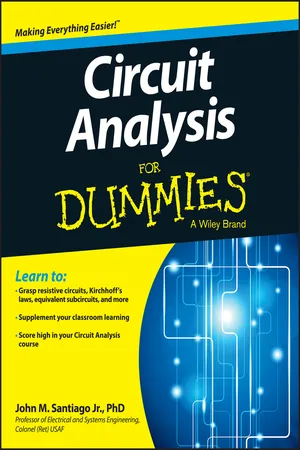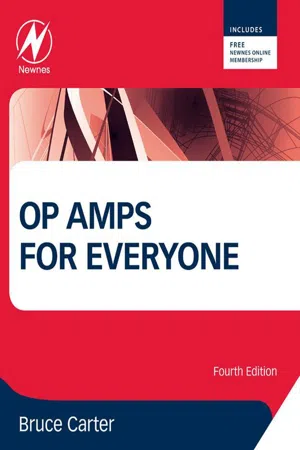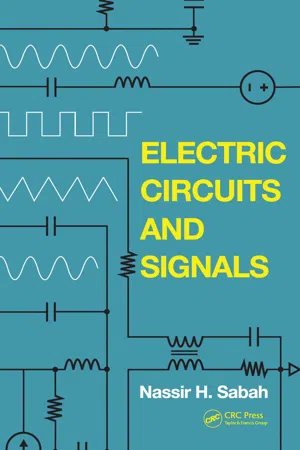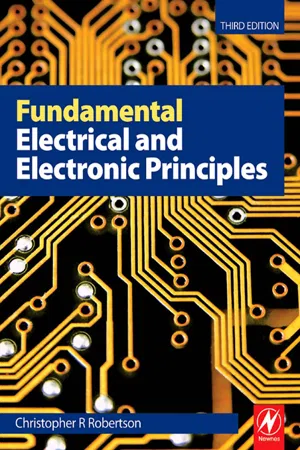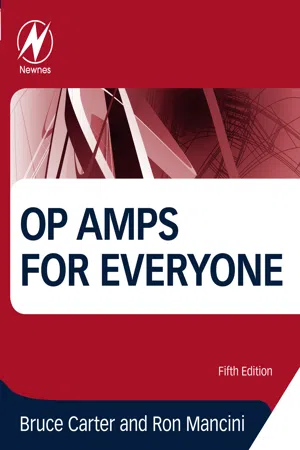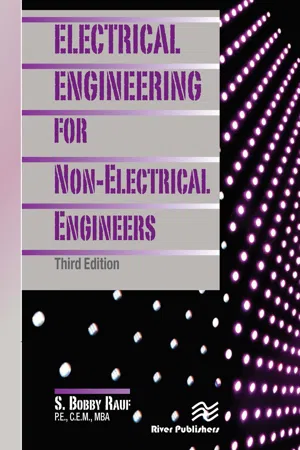Physics
Voltage Divider
A voltage divider is a simple circuit that divides a voltage into smaller parts using resistors. It consists of two or more resistors connected in series, and the output voltage is taken from the connection between the resistors. The voltage across each resistor is proportional to its resistance, allowing for precise control of the output voltage.
Written by Perlego with AI-assistance
Related key terms
Related key terms
1 of 4
Related key terms
1 of 3
7 Key excerpts on "Voltage Divider"
- eBook - ePub
- John Santiago(Author)
- 2013(Publication Date)
- For Dummies(Publisher)
Voltage Divider technique allows you to calculate the voltage for each device connected in series with an input voltage source. In the preceding section, I show you how to transform a circuit to a series circuit with a voltage source. This section shows you how to formulate the Voltage Divider equation. Then you see the Voltage Divider equation at work.If a circuit problem with a current source asks you to find the voltage for a particular device, you may find it easier to convert the circuit to a series circuit first. Then you can find voltage using the Voltage Divider technique.Getting a Voltage Divider equation for a series circuitYou use the Voltage Divider when the device in the circuit is connected in series and is driven by a voltage source. The input voltage source is divided proportionally according to the resistor values.To get the Voltage Divider equation, you start with the fact that for a series circuit, the same current flows through each resistor. With this current, you use Kirchhoff’s voltage law (KVL) and Ohm’s law to obtain the voltage across a particular resistor. You can solve for (or eliminate) the current in the expression. In the resulting equation, the desired voltage across the resistor is proportional to the input source voltage. Because the voltage source is multiplied by a ratio of resistors having a value of less than 1, the desired output and device voltage are always less than the input source voltage.Look at Circuit B of Figure 4-6 , which has a voltage source and three resistors connected in series. You want to calculate the voltage across the resistors.KVL says that the sum of the voltage rises and drops around a loop is equal to zero. So applying KVL to Circuit B produces the following:Because the circuit is connected in series, the same current i - eBook - ePub
- Bruce Carter(Author)
- 2012(Publication Date)
- Newnes(Publisher)
Equation 2.3 is written as Ohm’s law across the output resistor.(2.2)(2.3)Substituting Equation 2.2 into Equation 2.3 and using algebraic manipulation yields Equation 2.4 :(2.4)Figure 2.2 Voltage Divider RuleA simple way to remember the Voltage Divider rule is that the output resistor is divided by the total circuit resistance. This fraction is multiplied by the input voltage to obtain the output voltage. Remember that the Voltage Divider rule always assumes that the output resistor is not loaded; the equation is not valid when the output resistor is loaded by a parallel component. Fortunately, most circuits following a Voltage Divider are input circuits, and input circuits are usually high-resistance circuits. When a fixed load is in parallel with the output resistor, the equivalent parallel value comprised of the output resistor and loading resistor can be used in the Voltage Divider calculations with no error. Many people ignore the load resistor if it is 10 times greater than the output resistor value, but this will lead to a 10% error.2.2.3 Superposition
Superposition is a theorem that can be applied to any linear circuit. Essentially, when there are independent sources, the voltages and currents resulting from each source can be calculated separately, and the results are added algebraically. This simplifies the calculations because it eliminates the need to write a series of loop or node equations. An example is shown in Figure 2.3 .Figure 2.3 Superposition ExampleWhen V 1 is grounded, V 2 forms a Voltage Divider with R 3 and the parallel combination of R 2 and R 1 . The output voltage for this circuit (V OUT2 ) is calculated with the aid of the Voltage Divider equation (Equation 2.4 ). The circuit is shown in Figure 2.4 - eBook - ePub
- W. Bolton(Author)
- 2015(Publication Date)
- Routledge(Publisher)
2 X 25 = 5.76 W. The slight difference in the answers is due to rounding errors.9.4.1 Voltage Divider circuit
Figure 9.15 Voltage Divider circuitResistors in series can be used as a simple method of voltage division. Consider two resistors R 1 and R 2 in series, as illustrated in Figure 9.15 . A voltage V is applied across the arrangement.The total resistance is R 1 + R 2 . Thus the current I through the series resistors is:The voltage across resistor R 1 is IR 1 . Hence if this voltage is taken as the output voltage, we have:Thus the output voltage is the fraction R 1 /(R 1 + R 2 ) of the input voltage. The result is thus a voltage-divider circuit .It is often necessary to obtain a continuously variable voltage from a fixed supply voltage. For this a resistor with a sliding contact is used, such a circuit element being known as a potentiometer (Figure 9.16 ). The position of the sliding contact determines the ratio of the resistances R 1 and R 2 and hence the output voltage.Figure 9.16 PotentiometerExampleA potentiometer has a total track resistance of 50 Ω and is connected across a 20 V supply. What will be the resistance between the slider and the track end when the output voltage taken off between these terminals is 5.0 V?The potentiometer is effectively two resistors in series connected across the supply voltage (see Figure 9.16 ), namely the resistance between one end of the potentiometer and the slider and the resistance between the slider and the other end of the potentiometer. The fraction of the output voltage required is 5.0/20 and thus this must be the ratio of the resistance between one end and the slider to the sum of the two resistances, i.e. the total potentiometer resistance. Thus R /50 = 5.0/20 and so R = 12.5 Ω.9.5 Resistors in parallel
When circuit elements are in parallel (Figure 9.17 ) then the same potential difference occurs across each element. Since charge does not accumulate at a junction, then the current entering a junction must equal the sum of the current leaving it, i.e. I = I 1 + I 2 - eBook - ePub
- Nassir H. Sabah(Author)
- 2017(Publication Date)
- CRC Press(Publisher)
The Voltage Divider supplying a load at a reduced voltage is considered at the end of the chapter to illustrate a common and important feature of engineering design in general, namely, the trade-off between conflicting performance requirements. The example also illustrates the practical effects of tolerance of resistance values due to inevitable variations in component values during manufacturing.Learning Objectives
- To be familiar with:
- The definitions of terms used in circuit analysis, such as nodes, essential nodes, branches, essential branches, loops, and meshes
- To understand:
- The nature and significance of Kirchhoff’s current and voltage laws
- The basic characteristics of Voltage Divider and current divider circuits
- How resistances and conductances combine in series and in parallel
- The equivalence between nonideal voltage and current sources
- The fundamental concept of the equivalence of two circuits at a specified pair of terminals
FIGURE 2.1.1 Bridge circuit.
- The trade-off in the design of a resistive Voltage Divider supplying a load at a reduced voltage
2.1 Circuit Terminology
A node is the junction of two or more circuit elements. An essential node is the junction of three or more circuit elements. Normally, an essential node is indicated on circuit diagrams by a filled circle.A path is a set of one or more adjoining circuit elements that may be traversed in succession without passing through the same node more than once. A path generally has an initial node at its beginning and a final node at its end. If the initial and final nodes are the same, the path is closed and becomes a loop. A mesh is a loop that does not enclose any other loop.A branch is a path that connects two nodes. An essential branch is a branch that connects two essential nodes without passing through an essential node.Figure 2.1.1 shows a circuit configuration known as a bridge circuit. The nodes labeled a, b, c, and d are essential nodes, whereas nodes 1, 2, and 4 are not essential nodes. Nodes 3 and b are one and the same, as are nodes 3′, d, and 5 because no circuit element is connected between them, only a connection of zero resistance that is used for convenience of illustration. R src , v SRC , L 1 , R 1 , L 4 , R 4 , C 3 , and R 3 taken individually are branches. The combinations R src -v SRC , L 1 -R 1 , L 4 -R 4 , and the individual branches C 3 and R 3 are essential branches. The closed paths d-5-1-a-b-d and d-5-1-a-c-b-d are loops. The loops d-5-1-a-c-d, a-b-c-a, and d-c-b-d (going through C 3 ) are meshes. C 3 and R 3 - No longer available |Learn more
- C R Robertson(Author)
- 2008(Publication Date)
- Routledge(Publisher)
Chapter 2 D.C. Circuits2.1 Resistors in SeriesLearning OutcomesThis chapter explains how to apply circuit theory to the solution of simple circuits and networks by the application of Ohm’s law and Kirchhoff’s laws, and the concepts of potential and current dividers.This means that on completion of this chapter you should be able to:1 Calculate current flows, potential differences, power and energy dissipations for circuit components and simple circuits, by applying Ohm’s law.2 Carry out the above calculations for more complex networks using Kirchhoff’s Laws.3 Calculate circuit p.d.s using the potential divider technique, and branch currents using the current divider technique.4 Understand the principles and use of a Wheatstone Bridge.5 Understand the principles and use of a slidewire potentiometer.When resistors are connected ‘end-to-end’ so that the same current flows through them all they are said to be cascaded or connected in series . Such a circuit is shown in Fig. 2.1 . Note that, for the sake of simplicity, an ideal source of emf has been used (no internal resistance).Fig. 2.1Resistors cascaded or connected in seriesFrom the previous chapter we know that the current flowing through the resistors will result in p.d.s being developed across them. We also know that the sum of these p.d.s must equal the value of the applied emf. ThusV1 = IR1 volt; V2 = IR2 volt; and V3 = IR3 voltHowever, the circuit current I depends ultimately on the applied emf E and the total resistance R offered by the circuit. HenceE = IR volt. Also, E = V1 + V2 + V3 voltand substituting for E, V1 , V2 and V3 in this last equationwe have IR = IR1 + IR2 + IR3 voltand dividing this last equation by the common factor Iwhere R is the total circuit resistance. From this result it may be seen that when resistors are connected in series the total resistance is found simply by adding together the resistor values.Worked Example 2.1 Q For the circuit shown in Fig. 2.2 - eBook - ePub
- Bruce Carter, Ron Mancini(Authors)
- 2017(Publication Date)
- Newnes(Publisher)
Appendix AReview of Circuit Theory
A.1. Introduction
Although this book minimizes math, some algebra is germane to the understanding of analog electronics. Math and physics are presented here in the manner in which they are used later, so no practice exercises are given. For example, after the Voltage Divider rule is explained, it is used several times in the development of other concepts, and this usage constitutes practice.Circuits are a mix of passive and active components. The components are arranged in a manner that enables them to perform some desired function. The resulting arrangement of components is called a circuit or sometimes a circuit configuration. The art portion of analog design is developing the circuit configuration. There are many published circuit configurations for almost any circuit task, thus all circuit designers need not be artists.When the design has progressed to the point that a circuit exists, equations must be written to predict and analyze circuit performance. Textbooks are filled with rigorous methods for equation writing, and this review of circuit theory does not supplant those textbooks. But, a few equations are used so often that they should be memorized, and these equations are considered here.There are almost as many ways to analyze a circuit as there are electronic engineers, and if the equations are written correctly, all methods yield the same answer. There are some simple ways to analyze the circuit without completing unnecessary calculations, and these methods are illustrated here.A.2. Ohm's Law
Ohm's law is fundamental to all electronics. It can be applied to a single component, to any group of components, or to a complete circuit. When the current flowing through any portion of a circuit is known, the voltage dropped across that portion of the circuit is obtained by multiplying the current times the resistance (Eq. A.1 - S. Bobby Rauf(Author)
- 2021(Publication Date)
- River Publishers(Publisher)
Delta “Δ” load configuration, or vice and versa; conversion of complex circuits to Thevenin equivalent, Norton equivalent, two port networks, etc. However, these and many other advanced circuit analysis methods are outside the scope of this text.We will introduce the reader to two basic electronic devices, namely a diode and a transistor, their basic characteristics, and some of their applications. We will conclude this chapter with a pictorial “tour” of a typical electronic printed circuit board to allow the reader an opportunity to gain a measure of familiarity with basic electronic devices.Ohm’s Law
Ohm’s law was introduced, briefly, in Chapter 1. Ohm’s law stipulates that voltage, or voltage drop, in a DC (or AC) circuit is equal to the product of current flowing in the circuit and the resistance (or impedance) in the electrical circuit. In other words, voltage or voltage drop in an electrical circuit is directly proportional to the resistance (or impedance) of the circuit and the current flowing through it. Ohm’s law can, therefore, be stated mathematically as follows:V = I R , I =V R, o r R =V If o r D C C i r c u i t sEq. 2.1V ⇀=I ⇀Z ⇀,I ⇀=, o rV ⇀Z ⇀Z ⇀=f o r A C C i r c u i t sV ⇀I ⇀Eq. 2.2The first mathematical representation of Ohm’s law, in the form of Eq. 2.1 , pertains to DC circuits, and in this statement of Ohm’s law, all three parameters ―V, I, and R ― are scaler. On the other hand, mathematical representation of Ohm’s law, in the form of Eq. 2.2 applies to AC circuits, where voltage “V” and current “I” are vectors or complex entities and R, as always, is scalar. Note that the symbols with “half-arrows” above them denote complex AC, or vector, entities. These half arrows are shown here to introduce the reader to this method for representing vector or complex entities. Later in this text, vector or complex entities will be represented mostly in bold fonts. As one examines the statement of Ohm’s law in the form of Eqs. 2.1 and Eqs. 2.2 , it becomes obvious that the Ohm’s law can be interpreted and applied in several ways. This fundamental aspect of Ohm’s law, its versatility, and wide application will become more evident through various circuit analysis problems in this chapter, and others in this text, beginning with Example 2.1
Index pages curate the most relevant extracts from our library of academic textbooks. They’ve been created using an in-house natural language model (NLM), each adding context and meaning to key research topics.
Explore more topic indexes
Explore more topic indexes
1 of 6
Explore more topic indexes
1 of 4
